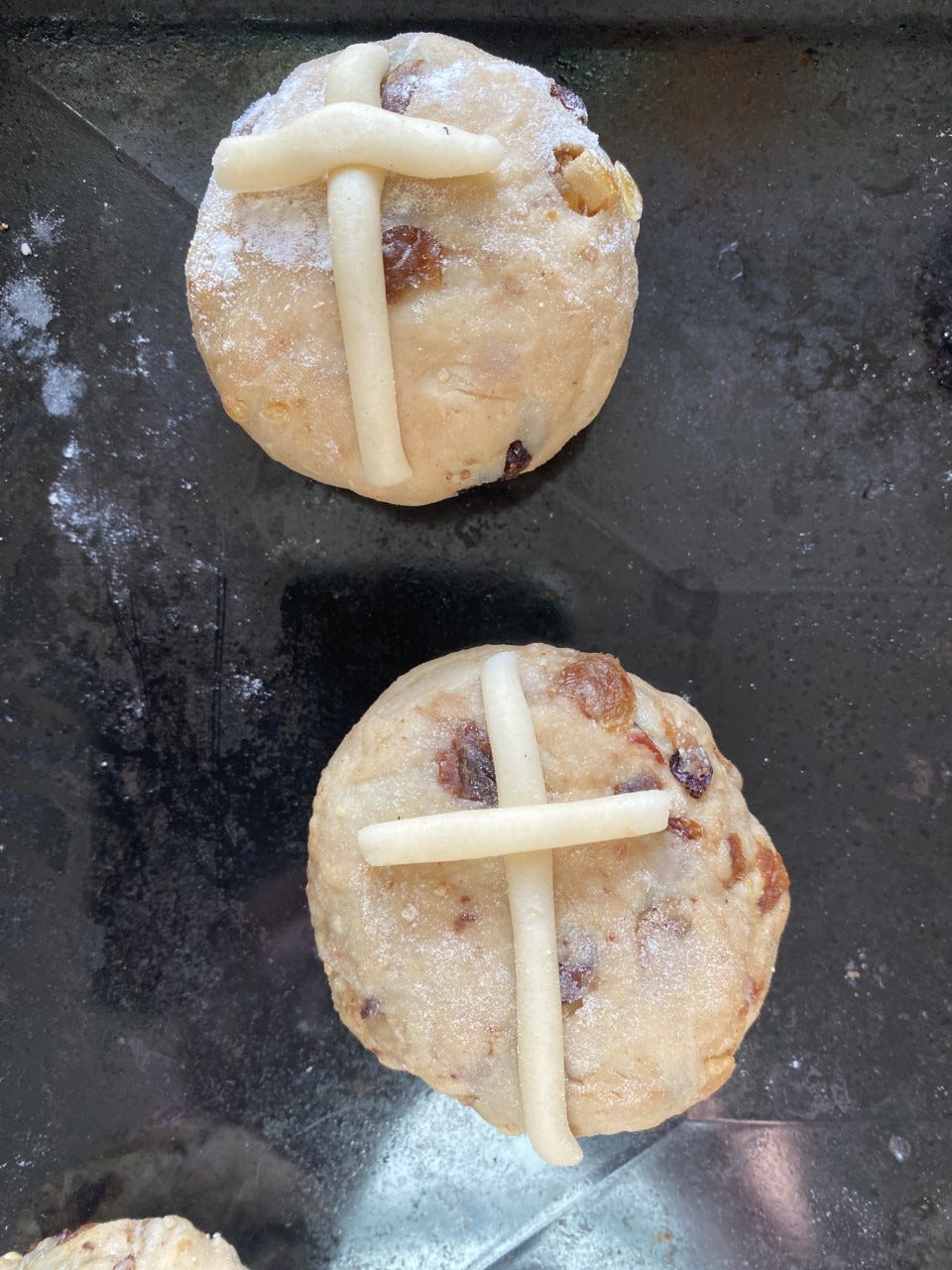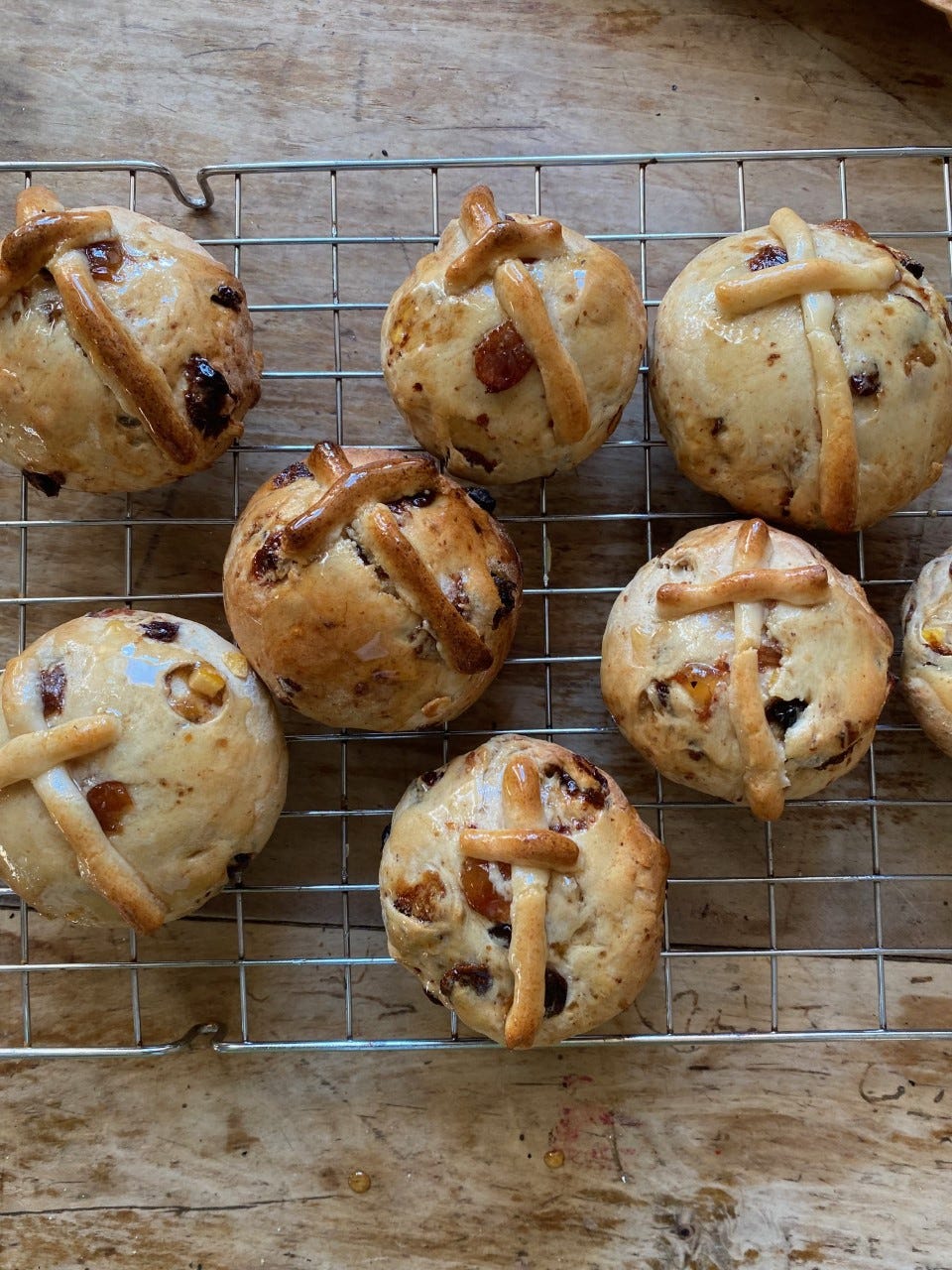Feasting in Holy Week
Hot cross buns!Hot cross buns! One ha' penny, two ha' penny,Hot cross buns! If you have no daughters, Give them to your sons. One ha' penny, Two ha' penny, Hot Cross Buns!
On the sixth and last Sunday of Lent, Inverarity Sunday School distribute palm crosses amongst the congregation. One week later two children stand either side of the Kirk door, with baskets of tiny Easter eggs, and encourage church goers to ‘dip in’ on departure. Eggs represent new life and for the Christian, a risen Lord. Palm Sunday, the start of Holy Week, the week preceding Easter, remembers the events of the last days of Jesus’ life on Earth.
On Palm Sunday Jesus requested figs (Mark 1: 12-14) as he rode on a donkey into Jerusalem. Throughout the bible the fig tree is a symbol of peace. Fig rolls would lend themselves to a Palm or as it was once called Fig Sunday, coffee morning. Await the recipe in my next book. Fig biscuits are still at the planning stage.
Many Churches have local traditions. In Inverarity, Angus, we celebrate Easter morning with a Kirk breakfast. The church is decorated on Easter Saturday and the congregation breakfast together, before Easter worship. On Palm Sunday, in certain churches, members of the congregation wave palms and the Vicar hands out Pax (taken from the Latin ‘peace’) Cakes. The 16th century Pax Cake recipe contains :icing sugar, corn flour, blossom syrup and is bound together with beaten egg white. It’s meringue like and very sweet. The cakes (which in my opinion are more biscuit than cake in style), were once stamped with a lamb and flag. A dove shaped biscuit cutter - a sign of peace - would work equally well. This baking idea is credited to a cake money bequest left by a Lady Scudmore. Feuding enemies would break and share a ‘Pax Cake’ at the church door, in anticipation of less animosity in the months going forward. A sort of moral compass, letting bygones be bygones.
In the North of England the fifth Sunday in Lent, the one before Palm Sunday, is called Carle or Carlin’ Sunday. This name comes from the tradition of preparing and eating marples, an old fashioned variety of pea also known as carling. The peas, possibly once cultivated by monks, require a long steep in water followed by slow cooking. Carlings are nutty in flavour. Once soaked (overnight),the peas are rinsed, simmered, drained and fried in butter and then seasoned with vinegar and pepper. More luxurious recipes add rum and sugar. The Carling snack, in common with Simnel Cake, eaten on Laetare Sunday or Mothering Sunday, the fourth Sunday in Lent, marked a break in Lenten austerity on Care or Carlin Sunday.
Sweet, spiced bread buns marked with a cross, are now in British supermarkets throughout the year. They contain a myriad of hybrid flavours. Salted Caramel and Lemon and Blueberry to name but two. I presume they are called hot cross buns because in days of yore, the bun was eaten freshly baked, straight from the oven - delicious. Originally called cross buns the buns were distributed on Good Friday, a fasting day. James Boswell writes of Dr Samuel Johnston, ‘ On the 9th April, being Good Friday, I breakfasted with him on tea and cross-buns.’ The cross was considered Popish (Catholic) in the Puritan era (16th century), but spices and the high dairy content of the leaven bread was acceptable on Good Friday.
The Cross Bun marks the celebration of Christ rising from the dead. The spices in the bun are associated with the oils that the women took to Jesus’ tomb, in the garden of Gethsemane at the foot of the Mount of Olive. I was tempted to add a dash of Oil of Cassia in place of mixed spices, but I have decided to save the oil for a day or two, to make Easter Day Biscuits.
Hot cross bun recipes vary. Wholemeal four gives a dense and chewy bun and seeds will add texture. Some recipes use three dairy products: milk, butter and eggs, others just butter and milk.I proved the rich dough overnight in the fridge because my schedule was busy. I liked the result. The buns rose well - portraying the true essence of the Easter message. I mixed and matched crucifix made from dried sea spaghetti and rolled marzipan.Rolling marzipan crosses is childsplay. Both crosses baked well. Savoury or Sweet. Take your pick. The simplest crucifix option is to use a knife to slash the dough with the sign of the cross. A flour and water cross detracts from the richness of the bun and doesn’t tempt my palate, but there is an obvious message in the use of simple ingredients - focusing on the austerity of the cross. Jesus was offered a cheap Roman wine vinegar to quench his thirst John 19: 29–30. Whatever crucifix you use, for the Christian, the cross is a symbol of hope, of good triumphing over evil.
For more Easter cooking meet Elisabeth Luard.









Will message you😀
Lovely. What recipe do you use?